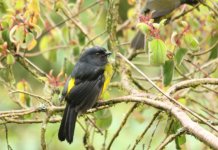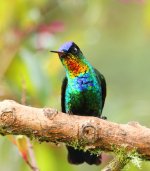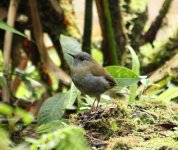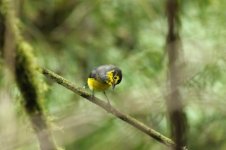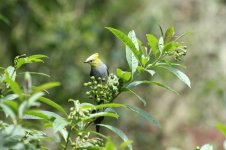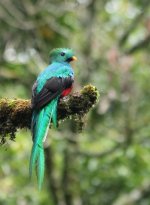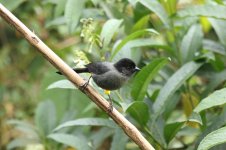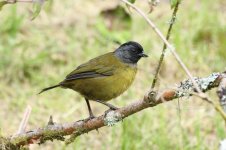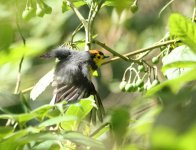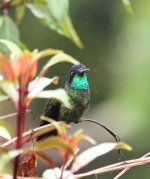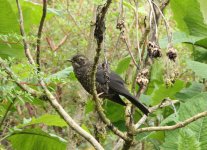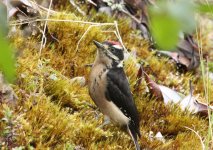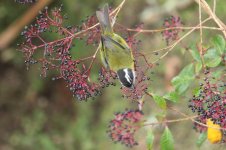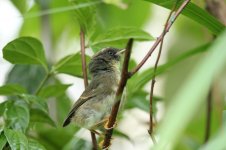ovenbird43
Well-known member

This week my husband and I traveled to Costa Rica for a few days, primarily to attend the joint meeting of the Association of Tropical Biology and Organization for Tropical Studies. I gave my talk on the first day of the conference, so I was able to sneak away for a little bit of birding toward the end of the week. This was my fourth visit to the country, so I wasn't expecting many lifers, mainly I wanted to enjoy a bit of tropical birding and take Tom out for a bit of exploration (this was his first trip).
A few logistics, for future reference for anybody interested:
We stayed at Hotel Rincon de San Jose for most of the week (we got a conference rate, normal rate $65 for a single), which was cozy and much more charming than typical chain hotels. The only downside was the long trek between our hotel (near downtown) and the conference venue, with a taxi ride costing anywhere between $20-40 for a half-hour ride. Fortunately our hotel arranged a shuttle for much cheaper. A taxi ride from the airport runs about $30.
We stayed for one night at Paraiso de Quetzales, a lodge within Tapanti National Park about an hour and half outside of San Jose in the Talamancas ($140 for us both, including dinner, breakfast, and a quetzal tour). To get there from San Jose, we took a bus toward San Isidro from the Musoc station and had the bus driver drop us off at the entrance road. From there it's a half-mile walk down the dirt road.
And now for the birds...
On June 26, after spending two full days at the conference, I left the hotel around 7 am and took a taxi to the University of Costa Rica campus. My target here was Prevost's Ground Sparrow, which according to the bird-finding guide is reliably found at the northeast corner of campus, by the nutrition school building. I wandered around campus for about an hour before I found the right area, all the while seeing numerous Crimson-fronted Parakeets overhead, Tropical Kingbirds, Rufous-collared Sparrows, Blue-gray Tanager, and Sulphur-bellied Flycatcher. Behind the nutrition building was a stream with secondary riparian forest with shrubs and grass, and a little table with a fruit feeder. Melodious Blackbirds and Blue-crowned Motmots were attending the fruit, and the area was rich in columbids: Red-billed Pigeon, White-winged Dove, Inca Dove, and White-tipped Dove. There were House Wrens, Plain Wrens, and Rufous-capped Warblers skulking in the shrubbery, and Clay-colored Thrushes feeding fledglings everywhere. I worked the edge of the stream for a good half hour, beginning to despair as I approached the edge of the property and the end of the habitat, but finally under a tree by the fence I spotted a distinctly ground-sparrow shape: sure enough, it was the Prevost's Ground Sparrow. I watched it as it foraged out in the open for a brief moment before retreating to the dense undergrowth by the stream. In the same area, I also spotted a pair of White-eared Ground Sparrows. Mission accomplished, I walked back to the entrance of the university, bought some empanadas to share with Tom, and caught a taxi back to the hotel.
I didn't take my camera to the university, but there will be lots of photos accompanying my report of Paraiso de Quetzales.
A few logistics, for future reference for anybody interested:
We stayed at Hotel Rincon de San Jose for most of the week (we got a conference rate, normal rate $65 for a single), which was cozy and much more charming than typical chain hotels. The only downside was the long trek between our hotel (near downtown) and the conference venue, with a taxi ride costing anywhere between $20-40 for a half-hour ride. Fortunately our hotel arranged a shuttle for much cheaper. A taxi ride from the airport runs about $30.
We stayed for one night at Paraiso de Quetzales, a lodge within Tapanti National Park about an hour and half outside of San Jose in the Talamancas ($140 for us both, including dinner, breakfast, and a quetzal tour). To get there from San Jose, we took a bus toward San Isidro from the Musoc station and had the bus driver drop us off at the entrance road. From there it's a half-mile walk down the dirt road.
And now for the birds...
On June 26, after spending two full days at the conference, I left the hotel around 7 am and took a taxi to the University of Costa Rica campus. My target here was Prevost's Ground Sparrow, which according to the bird-finding guide is reliably found at the northeast corner of campus, by the nutrition school building. I wandered around campus for about an hour before I found the right area, all the while seeing numerous Crimson-fronted Parakeets overhead, Tropical Kingbirds, Rufous-collared Sparrows, Blue-gray Tanager, and Sulphur-bellied Flycatcher. Behind the nutrition building was a stream with secondary riparian forest with shrubs and grass, and a little table with a fruit feeder. Melodious Blackbirds and Blue-crowned Motmots were attending the fruit, and the area was rich in columbids: Red-billed Pigeon, White-winged Dove, Inca Dove, and White-tipped Dove. There were House Wrens, Plain Wrens, and Rufous-capped Warblers skulking in the shrubbery, and Clay-colored Thrushes feeding fledglings everywhere. I worked the edge of the stream for a good half hour, beginning to despair as I approached the edge of the property and the end of the habitat, but finally under a tree by the fence I spotted a distinctly ground-sparrow shape: sure enough, it was the Prevost's Ground Sparrow. I watched it as it foraged out in the open for a brief moment before retreating to the dense undergrowth by the stream. In the same area, I also spotted a pair of White-eared Ground Sparrows. Mission accomplished, I walked back to the entrance of the university, bought some empanadas to share with Tom, and caught a taxi back to the hotel.
I didn't take my camera to the university, but there will be lots of photos accompanying my report of Paraiso de Quetzales.




